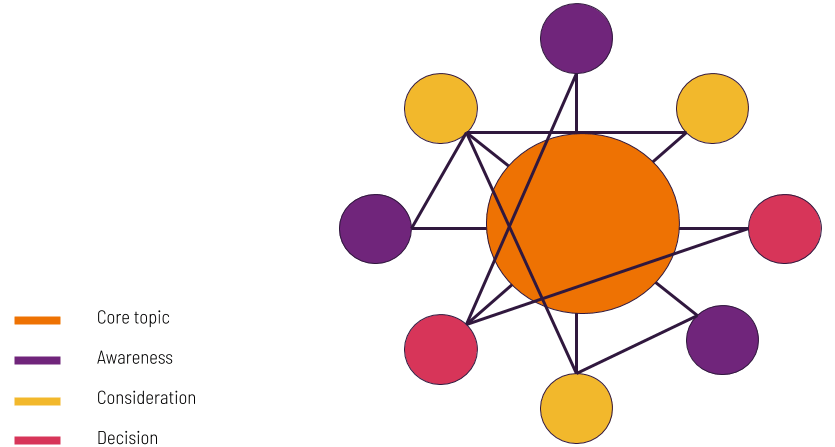Yes, the internet is a global stage where borders are somewhat obsolete. You can have an instant global reach from anywhere in the world. But that doesn’t mean that you can use the same messaging and strategy everywhere. Cultural differences matter and can impact the channels you use and the conversations you have with your audiences through them.
The European Union is a key market with almost 450 million consumers across 27 countries. It’s just 6% of the global population, but they generate 25% of the global nominal GDP.
This makes it a key global market full of opportunities for smart businesses. To market your products and services effectively, you need to take into account these key trends in digital and social media marketing in Europe.
1. An intense focus on customer experience

Businesses are now acutely aware of the impact of stellar customer experience on their revenue. According to research from Adobe, 22% of European businesses said that customer experience was their number one opportunity in 2020. In Germany, 27% of businesses and 28% of businesses in France, feel improving the digital customer experience was their top priority.
Aligning your business with the customer needs goes beyond providing an app with top usability or purchase and support experience. A big part of the customer experience is feeling good about where you spend your money. Businesses are looking to align their brand values with their customers, as more people, especially young consumers, become more conscious of their spending.
Not all brands will be successful in demonstrating their alignment with consumer values. Brands that make only superficial commitments to key issues may be called out on this, which can have a detrimental impact on their reputation. In certain markets and verticals, businesses could get away with it. However, being something that people have to use even if they hate it, instead of something that people love to use, makes your business ripe for disruption from a challenger.
The upside is that committing your business to align and defend your customers’ values has a long-term positive impact on your revenue as brand loyalty and repeat purchases grow.
2. Trust and transparency to drive data-driven strategies

With years of news about data breaches, privacy disasters, and whistleblowers revealing systemic data abuse, people have become very sensitive about their privacy and the way businesses manage their personal data. This has resulted in increased regulation that defines what businesses can and can’t do with their customers’ information. In addition to how they have to protect it, and their obligation to inform their customers about what information they have and what they do with it.
In Europe, the regulatory framework is the General Data Protection Regulation. This framework is then adapted by each country member into their own regulation. While there are minor differences, the core of the law is the same across the European Union, which simplifies compliance for businesses outside of Europe.
This law and overall trend around privacy and transparency have driven businesses in Europe to focus on first-party data, rather than third-party data to increase knowledge of their users. Developing marketing strategies around data collected with permission from users increases transparency and trust with your customers. Businesses looking to establish connections with individuals need to look beyond what data they gather, but at who is using that data to increase value for the business and to empower their customers. Now it’s not about gathering a lot of data, which increases the chance of a catastrophic breach or a failure in compliance but being smarter about how that data is being used across the customer lifecycle.
Customer data management is a key strategic issue that affects the whole organisation, because of the impact it has on the customer experience, from personalisation to transparency to compliance.
3. Personalisation through artificial intelligence

Almost 30% of European marketers are making personalisation one of their top priorities in 2020, according to research from Adobe. This number goes to 50% in the Nordics and Italy. Personalisation through smarter use of data to achieve better customer experiences may require significant investment in time and resources.
According to Forrester, 22% of marketing budgets are spent on technology on average. This number is set to grow, as two-thirds of marketers plan to increase their martech investment. One in five marketers in Europe will increase their budget for marketing technology in 2021 more than 10%.
But chasing the latest technology trends and acquiring the latest hot tool won’t save marketers from bad decisions and won’t magically make their organisations customer-centric. Larger European businesses are shifting to AI and machine learning to help them bring to reality the dream of a truly one-to-one marketing experience.
Businesses in Europe use AI and machine learning to help them with product recommendations, dynamic pricing, retention and marketing optimisation, allowing them to personalise their on-site experience.
AI can help businesses to deliver a truly personalised experience across the customer life cycle, but marketers should focus on the outcome – an improved customer experience which delivers higher ROI through smarter use of data, and not on chasing the latest tech trends.
4. Messaging apps and chatbots are the new hot marketing channel

Messaging apps like WhatsApp and Facebook Messenger have drastically changed the way we communicate with friends, family and coworkers. It’s no surprise that businesses everywhere want to explore those channels to reach their existing and potential customers.
Both apps are top 1 or 2 in usage across all countries in the European Union. Other messaging apps, like Telegram, Line or Signal are also used, but they mostly fill niche needs. In the case of messaging apps, like in social networks, having a critical mass of users is key for their success. Only WhatsApp and Facebook Messenger (both owned by Facebook) have that kind of penetration in the European market.
Both apps have options for businesses to create profiles. WhatsApp Business has more than 3 million companies using its capabilities worldwide, by the latest public statistics. This represents a good opportunity to develop an early presence in one of the most used communication channels in the world.
WhatsApp Business API lets you create rule-based and natural language processing chatbots through a third-party provider. This will let you interact with customers instantly at any time and integrate those conversations into your overall marketing strategy and tech stack. For example, you can integrate your chatbot with an email marketing provider. This allows you to subscribe users to a newsletter when their email is provided. According to research, the chatbot market in Europe is growing at a rate of 30% each year.
Gamescom, the largest gaming event, held in Germany, uses a WhatsApp chatbot to support attendees before the fair and to help them navigate the space during the actual event. Here you can see more examples of European chatbots, from companies like Deutsche Telekom, BMW or Spanish oil company Cepsa.
5. Targeted, relevant content is key to drive the brand storytelling

Users are now drowned in content. Businesses that want to stand out in a global competition for their audience attention need to focus on their users’ needs and reach out to them where they are.
This means not just pushing promotions and sales, but delivering content that adds value to their lives. European consumers are quite critical, and according to research from Hubspot, they tend to not trust ads on Facebook. The company has taken plans to further reduce the number of business content impressions people see on Facebook. This will reduce again the organic reach of business on that social network. Nevertheless, Facebook is still the most popular social media network in Europe. Any plans to reach out to consumers in the region must include Facebook in the strategy.
Among alternative platforms, Snapchat is becoming less used in Europe, even though the format they pioneered, the Story, is now more popular than ever. Globally, 500 million Instagram users view stories daily. This has made the format an attractive advertising channel in which to invest. 45% of Instagram ad spend is on promoted stories.
The key is to drive high-quality, relevant content that addresses the user needs through the channels they use more often. It may be Facebook, LinkedIn, Instagram, chatbots or a combination of several platforms.
A key market with demanding customers
Europe is mostly aligned with global marketing and social media trends. But consumers may be more demanding of businesses when it comes to aligning their spend with their values. People in Europe have also high expectations when it comes to the handling of their data and respect for their privacy. They want personalised and high-quality customer experiences. They are loyal to brands that add value to their lives through their products and content.
Companies looking to develop effective marketing strategies in the European market need to be mindful of these differences and particularities to gain the attention and trust of consumers.









